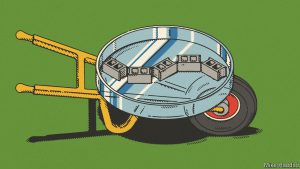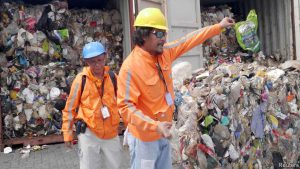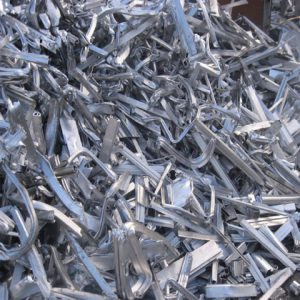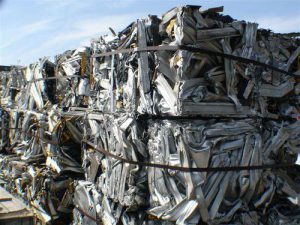By Kate Ashton
Posted Sat 11 Jun 2022 at 4:06am, updated Sat 11 Jun 2022 at 6:40am
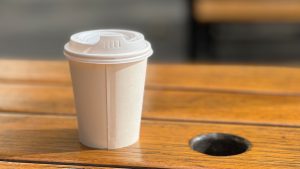
Despite the alternatives on offer, many Australians are still opting for disposable coffee cups.(ABC News: Joseph Dunstan)
If you’ve ever felt a pang of guilt as you sipped hot coffee from a takeaway cup, you’re not alone.
While reusable cups have been around for a while, data suggests plenty of Australians are still reaching for the disposable option.
Australians consume an estimated 2.7 million coffee cups a day, the vast majority of which end up in landfill, according to Sustainability Victoria.
That’s why Melbourne engineer Yanni Bouras has been trialling ways to turn old coffee cups into something useful.
“As a structural engineer, there’s two things I love, coffee and concrete,” he said.
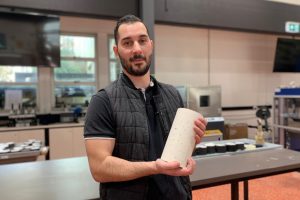
Yanni Bouras hopes his innovation can be used for things like construction or footpaths. (ABC News: Kate Ashton)
The Victoria University (VU) engineering lecturer and his colleagues have been examining different waste materials that can be used as part of a concrete mix.
“We were having coffee one day in the cafe here at VU and we sort of looked at the coffee cups and thought, ‘why not give this a go?'” he said.
The cups are ground up and mixed in as a substitute for a proportion of the sand that goes into a typical concrete mix.
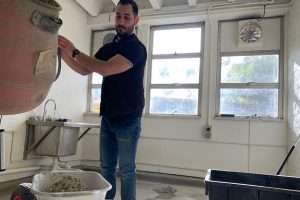
Dr Bouras and his team are working on new ways to make concrete.(ABC News: Kate Ashton)
So far, testing has found the material is weaker than standard concrete but has a higher thermal performance.
That means it could be useful for non-structural purposes, like footpaths or even insulation.
If 10 per cent of sand was replaced by takeaway coffee cups, there could be up to 700 coffee cups used per cubic metre of concrete.
“We do need to find ways to build greener and more sustainably, so solutions like this are quite important,” Dr Bouras said.
Industry shifting to reduce reliance on single-use packaging
While people like Dr Bouras investigate novel ways to repurpose coffee cup waste, many individual businesses are working on reducing their consumption.
Christian Sullivan McNeill co-owns a café in Brunswick in Melbourne’s inner north, that has made some recent tweaks to try and minimise plastic waste.
“The changes weren’t big themselves, but we just needed a little bit of advice in what changes to make,” he said.
Mr Sullivan McNeill’s cafe is now using coffee cup lids made from corn starch, which are fully home compostable.
They have also moved away from plastic straws and cutlery.
“It wasn’t until we were able to get advice, that we realised that there are more sustainable products out there, especially with our lids,” he said.

Cafe owners say the past two years of the pandemic interrupted the shift towards reusable cups. (ABC News: Alkira Reinfrank)
In her role as Plastic Free Places co-ordinator for Victoria, Birte Moliere meets with businesses, like Mr Sullivan McNeill’s cafe, to examine what plastic products they use and give advice on what they can eliminate or replace.
“We do have a lot of businesses who are very confused at the moment around what they are allowed to use, what they’re not allowed to use, and what is the more sustainable option for them,” she said.
“It is incredibly confusing in Australia because at the moment, we don’t have mandatory labelling around our packaging, which makes it hard for our businesses to find what is right.”
She said it was encouraging how many businesses were willing to adopt more sustainable packaging options, and they often found there was little to no price difference.
Victoria creeps closer to single-use plastics ban
From February 2023, Victoria will introduce a single-use plastics ban.
The ban will include polystyrene packaging, plastic straws, cutlery, plates and drink stirrers, but the proposed rules won’t wipe out takeaway coffee cups or lids just yet.
Space to play or pause, M to mute, left and right arrows to seek, up and down arrows for volume.
The government is urging businesses to run down stocks and switch to alternate items before the ban comes in.
The message Ms Moliere wants to get across is that reusable options are always the most sustainable.
She said while finding new second uses, like coffee cups in concrete, was a start, it was not a perfect solution.
“We are heavily reliant at the moment on single use, and that really needs a big rethink,” she said.
Ms Moliere said a greater focus was needed on the “circular economy”, where materials were reused for quite some time.
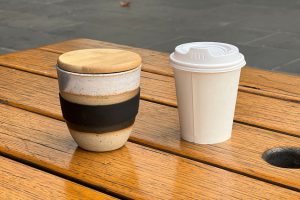
Environmental advocates say choosing a keep cup over a disposable cup is the best way to tackle the issue.(ABC News: Joseph Dunstan)
The same could be said for switching to better alternatives, like compostable bio-plastics, which use less energy to produce and break down, but are still ultimately a single use product.
“For coffee cups, the simplest and best thing is to just go to re-usables,” she said.
In addition to changing products in their cafe, Mr Sullivan McNeill said they were also making efforts to encourage customers to bring their own re-usable cup or forgo a plastic lid.
He said people were still getting back into the habit of bringing their re-usable cups after it took a hit during the past two years of the COVID-19 pandemic.
“What we were up to [with reusable cups] before COVID, we are not fully there yet. But it is coming back slowly, I guess,” he said.
Posted 11 Jun 2022, updated 11 Jun 2022
Link: abc.net.au/news/disposable-coffee-cups-lids-plastic-recycling-waste-landfill/101138922
